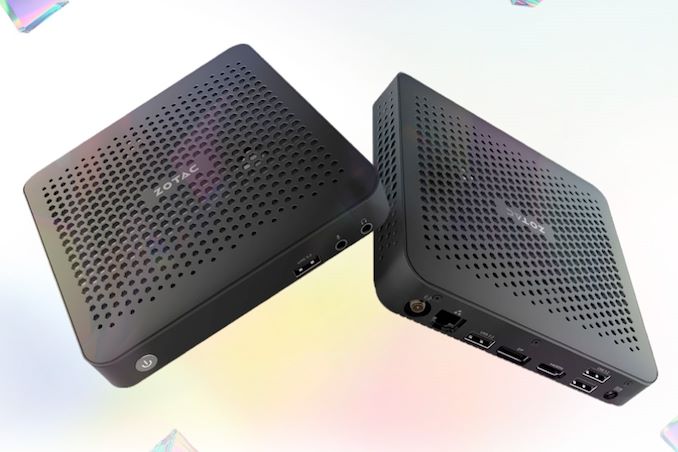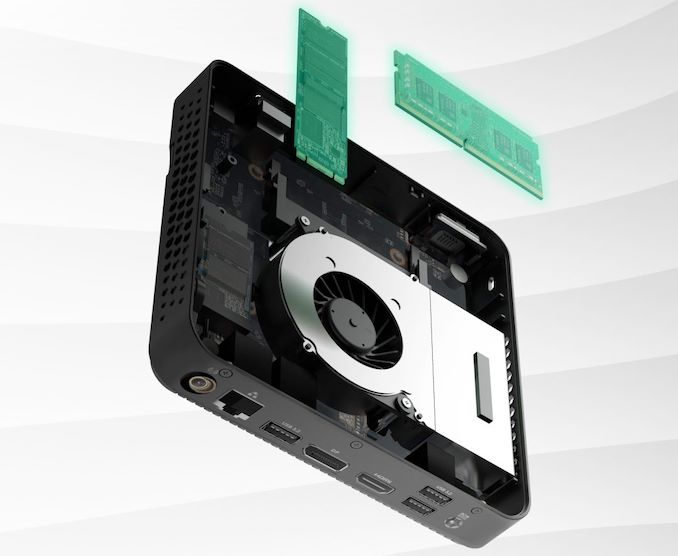Zotac’s Zbox Edge MI351 Packs Alder Lake-N and Offers Upgradeability
by Anton Shilov on April 14, 2023 5:00 PM EST
Introduced back at CES 2023, Intel’s Alder Lake-N platform is the company's newest and latest budget platform for entry-level PCs. With the hardware now shipping, Zotac is among the first well-known PC makers to offer use the platform for its Zbox Edge MI351 mini-PC. Though it's not as small as some of its competitors, it offers a degree of upgradeability and plenty of ports.
The Zotac Zbox Edge MI351 is based around Intel's N100 processor, which offers four Gracemont CPU cores operating at 800 MHz – 3.40 GHz and an Intel Xe-based iGPU with advanced media decoding (AV1, H.264, H.265, etc.) and encoding capabilities. From performance point of view, Intel's N100 should offer performance comparable to that of quad-core Skylake-class processors from 2015 – 2018, albeit with much more sophisticated multimedia engine. The latter of which is important not only for HTPCs, but also for various other applications N100 devices are aimed at, including kiosks and digital signage.
Looking at the MI351's design itself, it's interesting to see that Zotac opted to use an active cooling system with a fan to cool down the N100 processor. The official TDP of the N100 is just 6 Watts, but as Intel's modern TDP mantra means that chips are allowed to consume much more energy than that when turbo boosting, manufacturers are increasingly designing their boxes to sustain higher thermals in order to keep performance up.
The PC also offers a decent degree of upgradability for a budget, Atom-class box. Zotac hasn't soldered down any memory or NAND storage – a common sight in these devices – so the Zbox Edge MI351 offers a DIMM slot for a DDR5-4800 memory module as well as an M.2-2280 PCIe 3.0 x4 slot for a standard NVMe SSD.
Zotac's Zbox Edge MI351 also offers above-average connectivity for a low-end mini-PC. Besides a GbE port, four USB 3.2 ports Type-A ports are available (one on the front), as well as two 4Kp60-capable display outputs (DisplayPort 1.4, HDMI 2.0), and the usual 3.5mm audio in/out connectors. Wireless connectivity is also available via an integrated Wi-Fi 6 + Bluetooth 5.2 controller – though an external antenna (included) is needed to make use of them.
The trade-off for including room for DIMMs and M.2 SSDs, however, is that it requires a slightly larger footprint for the PC. Zotac's Zbox Edge MI351 system measures 149.5 mm x 149.5 mm x 28.5 mm (5.89 in x 5.89 in x 1.12 in), which is a tad smaller than Apple's M1 Mac Mini, but which is larger than many Atom-based systems. Still, the box is more than small enough that it offers VESA mounts, allowing one to hide it on the back of the display.
Finally, Zotac is not disclosing pricing for its Zbox Edge MI351 at this time. Keep in mind that this is being sold as a barebones unit, so buyers will need to include RAM and storage in their budget, as well as a copy of an OS.
Source: Zotac (via Liliputing)












16 Comments
View All Comments
nandnandnand - Friday, April 14, 2023 - link
Single channel memorySamus - Saturday, April 15, 2023 - link
It's a low-end PC. Thing has Haswell performance and a really weak Xe configuration, not sure dual channel is going to save it. Not that it could if Zotac wanted it too - the N100 only has a single memory channel. But it's 6 watts.meacupla - Saturday, April 15, 2023 - link
Having used a N5105, which has similar performance to an i5-3470, I can tell you that I felt no difference in performance between 8GB single channel, and 16GB dual channel.N100 has similar performance to a i5-6500, so I doubt having dual channel would improve perceived performance too.
The main bottleneck on these 6W CPUs is going to be processing power.
erinadreno - Saturday, April 15, 2023 - link
Since it's using DDR5, the dual channel issue may not be so severe as their dual channel in single module shenanigans. But definitely werid for intel only putting single channel controller on ALL alderlake N productsmeacupla - Saturday, April 15, 2023 - link
Like I said, the difference in single channel and dual channel cannot be felt, even with DDR4 2933, because the CPU/iGPU is so slow. They have comparable processing power to low end i5 CPUs from 8~10yrs ago, and those CPUs were still using DDR3 or slow DDR4 back then.DDR5 4800 offers more than enough bandwidth for something that slow.
Otritus - Sunday, April 16, 2023 - link
DDR5-4800 in single channel mode delivers more bandwidth than the i5-6600 had available, and that's the level of CPU performance that's expected from this processor at its peak. Rather than waste die space, power consumption, and physical space, it is much more logical to exclude the second channel on the processor.StevoLincolnite - Sunday, April 16, 2023 - link
I think people forget that Integrated Graphics has gotten far more bandwidth demanding these days as they have gotten more capable.Dual-Channel would definitely have been a benefit, maybe not so much for the CPU, but definitely the GPU.
meacupla - Sunday, April 16, 2023 - link
Except Alderlake-N only features a maximum of 32EU, and the N100 only features 24EU.Dual channel or not, it's not going to matter, the bottleneck will always be at the very cut down GPU.
If it had a 80EU or 96EU Xe graphics, like the i5 and i7 have, then yeah, dual channel will make a small difference in some games. But for media playback? unlikely.
abufrejoval - Sunday, April 16, 2023 - link
Same as the Jasper Lake 6005. I benched it with single and dual channel on an Intel NUC and it makes a very noticeable difference on desktop work at 4k. In fact the N6005 is a rather competent desktop PC for any 2D office work at 4k on Windows.And running Google Maps' 3D render on a Chrome based browser like Chromium or Brave with proper acceleration support at 4k under Windows on an Atom is always a jaw dropping marvel, especially if Microsoft's flight simulator struggles even with an RTX3090 and a Ryzen 5950X right next to it (delivering a far worse approximation of the ground truth as well).
Just don't try that with Firefox or on anything but the most up-to-date Linux variants.
For media playback or at lower resolutions you may not be able to tell.
abufrejoval - Sunday, April 16, 2023 - link
I got into Atoms with the J1900, which was terrible even at 1080p. N3700 and J5005 became ok and the N6005 in Jasper Lake became reasonable even at 4k (I am talking 2D here).The early Atoms clearly didn't benefit from a 2nd DIMM, because they had a single memory channel controller on the SoC: I stuffed them with RAM because I needed that for VMs and was happy to notice that they usually accepted much more than Intel ever said they could (16GB on all DDR3 variants, 32GB on anything DDR4, 64GB with Jasper Lake).
But Jasper Lake already has a dual channel memory controller and shows nearly double the bandwidth (~20GB/s instead of ~10GB/s on a single channel), but still falls way below the near 45GB/s an Intel Core or Ryzen gets out of DDR4.
On the CPU side that doesn't matter that much but on a 4k screen I definitely notice the difference (as Browser benchmarks will also attest).
With Gracemont that can't be less true so crippling the system with a single DIMM slot is definitely a noteworthy shortcoming for the iGPU, although not for everyone.
And I really would like to see an N305 variant, which somehow I believe will be near impossible to get, because Intel doesn't want you to get chips with server potential for cheap.
Such a chip should put my Broadwell based 8-core Xeon D-1541 to shame!